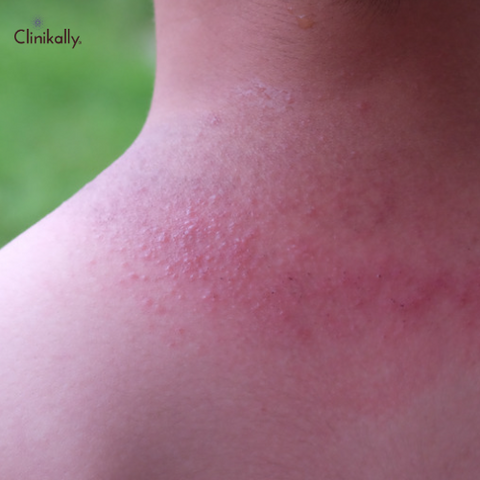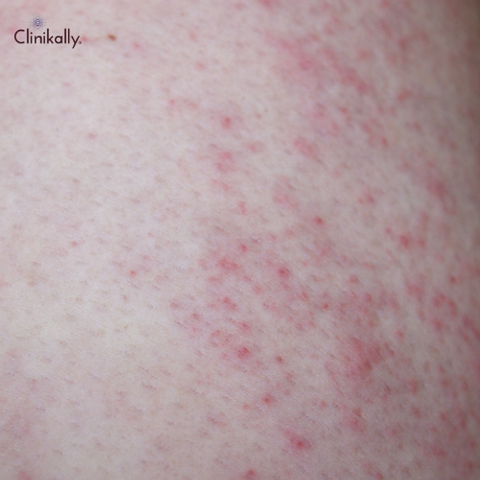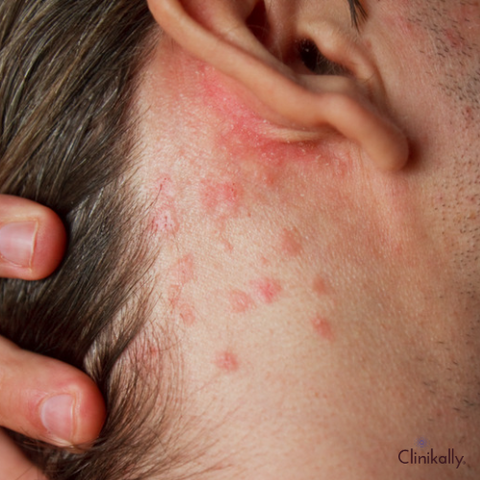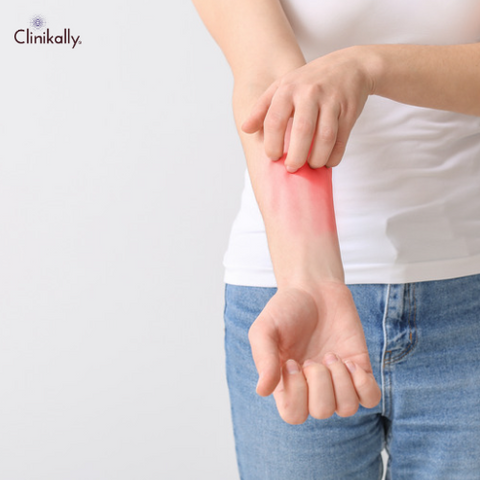Heat rash, also known as prickly heat and miliaria, is not limited to infants. It affects adults as well, especially in hot, humid weather. Sweat becomes trapped in the skin, causing heat rash. Small blisters and deep, inflamed lumps are common symptoms. Some types of heat rashes are extremely itchy. Heat rash usually disappears when the skin cools down. Severe cases of the condition may necessitate medical attention. It most commonly affects adults in hot, humid weather or during physical activity.
The causes of heat rashes are excessive sweating due to hot and humid weather, wearing tight or non-breathable clothing, prolonged bed rest or immobility, intense physical activity or exercise, and certain medications that can cause sweating, fever, or hyperthyroidism. The symptoms of heat rashes are small red bumps on the skin, swelling and redness, an itching or prickling sensation on the affected area, and blistering in severe cases. The effective treatment of heat rashes is to cool and dry the affected area by staying in an air-conditioned room or using a fan, wearing loose-fitting, breathable clothing, avoiding using heavy creams or lotions, and avoiding scratching the affected area. Applying a cool compress to the affected area and calamine lotion or hydrocortisone cream can help relieve itching and redness.
There are instances where a heat rash can develop into more serious symptoms like an infection, a fever, and heat exhaustion. It is imperative to see a doctor if the rash spreads, becomes more painful, or does not get better after several days of home treatment. In conclusion, heat rash in adults is a common condition that has a number of potential causes. The affected area must be kept cool and dry during treatment and wearing tight or impermeable clothing must be avoided. To avoid more serious complications, seek medical help if symptoms worsen or do not improve after several days.
Understanding Heat Rash in Adults

Heat rash, also known as prickly heat or miliaria, is a common skin condition that occurs when sweat glands become blocked and sweat is unable to escape the skin. Adults who live in tropical areas or who regularly engage in strenuous physical activity are more likely to develop it when it is hot and humid outside.
The condition typically manifests as itchy, tiny, red bumps on the skin. Heat rash can happen anywhere on the body, but it typically affects the neck, chest, back, groin, and armpits because these are places where the skin folds or rubs together. Heat rash can be brought on by a number of things, such as being outside in hot, muggy weather, wearing constricting or unbreathable clothing, engaging in strenuous physical activity, and taking medications or having certain medical conditions that result in excessive sweating.
Treatment for heat rash involves keeping the affected area cool and dry, wearing loose-fitting, breathable clothing, and avoiding heavy creams or lotions that can clog sweat glands. In some cases, over-the-counter products such as calamine lotion or hydrocortisone cream can help relieve itching and redness.
Avoiding exposure to hot, muggy weather is the best way to prevent heat rash, as is dressing in airy, loose-fitting clothing, stopping frequently to rest while exercising, and drinking lots of fluids to stay hydrated. The majority of the time, heat rash is a minor condition that is easily treatable and curable. However, it is crucial to get medical help if the rash spreads, becomes more painful, or does not get better after several days of home treatment in order to avoid more serious complications.
The Role of Sweat Glands and Overheating
Sweating, which evaporates from the skin's surface and aids in cooling the body, is produced by sweat glands, which play a significant part in controlling body temperature. When the body overheats, sweat glands produce more sweat, which helps dissipate heat and maintain a normal body temperature. The development of heat rash or prickly heat is caused when sweat glands become blocked, preventing the sweat from evaporating from the skin. This is more likely to happen in hot and muggy conditions, during vigorous exercise, or in people who are dressed in tight or unbreathable clothing.
When sweat glands are clogged, sweat can accumulate beneath the skin, resulting in inflammation and the development of tiny, red bumps on the skin. These lumps may itch, are unwelcome, and may develop into more serious symptoms like blistering, swelling, and infection. To prevent heat rash, it is important to stay cool and dry in hot and humid weather, wear loose-fitting, breathable clothing, and take frequent breaks during physical activity. In order to replace the fluids lost through sweating, it's crucial to stay hydrated by drinking a lot of liquids.
Types of Heat Rash: Miliaria Crystallina, Miliaria Rubra, and Miliaria Profunda
Miliaria profunda, miliaria rubra, and miliaria crystallina are the three main types of heat rash, which are also referred to as prickly heat or miliaria.
The mildest type of heat rash is called miliaria crystalline, and it usually affects the sweat ducts in the epidermis. On the skin's surface, it appears as tiny, easily burstable blisters filled with a clear, fluid-filled fluid. The blisters typically don't itch or hurt, and they usually go away by themselves in a few days.
The most typical type of heat rash, miliaria rubra, also known as prickly heat, affects the sweat ducts in the deeper layers of the skin. It manifests as tiny, uncomfortable, red bumps on the skin that can itch. The rash typically appears on the neck, chest, back, groin, and armpits because these are places where the skin folds or rubs against itself. Miliaria rubra can occasionally cause more serious symptoms like infection, swelling, and blistering.
The least frequent type of heat rash, miliaria profunda, affects the sweat ducts in the skin's deepest layer. It appears on the skin as hard, flesh-colored bumps that can hurt and itch. It can be challenging to treat Miliaria profunda, which typically appears in people who have had repeated episodes of heat rash.
The most common treatment for heat rash is to keep the affected area cool and dry, to wear loose-fitting, breathable clothing, and to avoid using heavy creams or lotions that can clog sweat glands. In some instances, over-the-counter items like calamine lotion or hydrocortisone cream can aid in reducing redness and itching. To avoid more serious complications, it is crucial to seek medical help if the rash spreads, becomes more painful, or does not get better after several days of home treatment.
Symptoms and Diagnosis of Heat Rash in Adults

Depending on the type and severity of the condition, heat rash symptoms in adults can change. However, typical signs include:
-
Small, red bumps on the skin
-
Itching and discomfort
-
A prickly or stinging sensation on the skin
-
The affected area may feel warm to the touch
-
In more severe cases, swelling, blistering, or infection may occur
The appearance of the rash and a history of exposure to hot, muggy weather or other circumstances that can lead to excessive sweating are typically used to diagnose heat rash. It may be necessary to perform a skin biopsy in some cases to confirm the diagnosis and rule out other conditions that could manifest similar symptoms. In order to prevent more severe complications, it is essential to get medical help if the rash spreads, becomes more painful, or does not get better after several days of home treatment. A medical expert can perform a physical examination and might advise additional tests or treatments to help manage symptoms and prevent complications.
Itching, Redness, and Bumps: Recognizing the Signs of Heat Rash
The skin condition known as heat rash, also referred to as prickly heat or miliaria, is quite common and can result in itching, skin redness, and bumps. The severity of the condition and the type of heat rash that is present can affect the signs of heat rash. The mildest type of heat rash, miliaria crystallina, manifests as tiny, transparent, fluid-filled blisters on the skin's surface that rarely itch or feel uncomfortable. The most typical type of heat rash, miliaria rubra, manifests as tiny, irritable red bumps on the skin. The neck, chest, back, groin, and armpits are typical locations for the rash to appear where skin folds or rubs against itself. The least frequent type of heat rash, miliaria profunda, presents as firm, flesh-colored bumps on the skin that can be uncomfortable and itchy.
The appearance of the rash itself typically serves as a good indicator of the signs and symptoms of heat rash. The skin may be bumpy or blistered, and it may be red and inflamed. There may be a prickling or stinging sensation on the skin, as well as a warm sensation when you touch the affected area. In the event that you experience any of these signs, it's critical to take action to cool off and stop additional perspiration. This might entail moving to a cooler environment, dressing in light, loose-fitting clothing, and staying away from strenuous exercise. Using cool compresses on the skin or soaking in a cool bath can also help to calm the skin, ease itching, and reduce discomfort. To avoid complications, it's critical to seek medical attention if the rash does not lessen or gets worse.
When to See a Doctor: Diagnosis and Treatment Options
The majority of heat rash cases can be effectively treated at home and usually go away on their own in a few days. However, if the rash does not improve or becomes more severe, it is essential to seek medical attention to prevent complications. A healthcare professional can conduct a physical examination and might suggest extra investigations or therapies to help manage symptoms and avoid complications. Treatment choices could be:
-
Topical creams or ointments to reduce itching and inflammation
-
Antihistamines or other medications to reduce itching and discomfort
-
Antibiotics or other medications to treat bacterial infections that may occur in more severe cases
-
Cool compresses or baths to soothe the skin and reduce inflammation
If the rash spreads, becomes more painful, or does not get better after several days of home treatment, it is crucial to seek medical attention. It is important to seek prompt medical attention to avoid complications from heat rash, which can sometimes result in more serious complications like bacterial infections.
Treating Heat Rash in Adults

The majority of the time, self-care techniques can be used to treat heat rash, prickly heat, or miliaria. The following advice is for treating heat rash in adults:
-
Cool the affected area: The affected area must be cooled down as the first step in treating heat rash. To help cool the skin, leave the warm area and use a fan. You can also apply cool compresses or take a cool bath to help soothe the skin.
-
Wear loose-fitting clothing: Tight clothing can trap heat and sweat against the skin, worsening heat rash symptoms. Wear loose, breathable clothing made from natural fibers like cotton.
-
Keep the skin dry: Excessive sweating can worsen heat rash symptoms. Keep the affected area dry by using talcum powder or corn-starch to absorb excess moisture.
-
Avoid strenuous activity: Strenuous physical activity can cause excessive sweating and worsen heat rash symptoms. Avoid exercising or other strenuous activities until the rash has cleared up.
-
Use over-the-counter medications: Over-the-counter creams and ointments that contain calamine or hydrocortisone can help relieve itching and reduce inflammation.
Most cases of heat rash will clear up on their own within a few days with these self-care measures. However, it is imperative to seek medical attention if the rash spreads, becomes more painful, or does not get better after several days of home treatment in order to avoid complications. To help manage symptoms and avoid complications, your healthcare provider might suggest additional therapies or medications.
Topical Treatments for Heat Rash: Calamine Lotion, Aloe Vera, and Hydrocortisone Cream
There are a number of topical medicines that can effectively treat heat rash, including:
-
Calamine lotion: Calamine lotion can relieve itching and irritation while also soothing the skin. It works by drying out the blisters and reducing inflammation. Apply calamine lotion to the affected area as directed by the package instructions.
-
Aloe vera: Aloe vera gel is well-known for its calming and cooling qualities and can be useful in reducing the swelling and redness brought on by heat rash. Apply a thin layer of aloe vera gel to the affected area several times a day.
-
Hydrocortisone cream: Hydrocortisone cream purchased without a prescription can help to lessen the itching and inflammation brought on by heat rash. Apply a thin layer of cream to the affected area as directed by the package instructions.
These topical medications should be applied as prescribed and away from any broken or infected skin. You should stop using the medication and speak with your healthcare provider if your symptoms do not get better or if you experience any side effects. It's important to keep in mind that, even though these remedies can be useful in treating symptoms, it's also crucial to take precautions to avoid getting heat rash in the first place by staying cool, dry, and avoiding excessive perspiration.
Home Remedies for Heat Rash: Oatmeal Baths and Other Soothing Techniques
There are several natural remedies for treating heat rash in addition to over-the-counter medications:
-
Baths with oatmeal: Oatmeal can be used to calm irritated skin and lessen inflammation. In a cool bath, add 1-2 cups of colloidal oatmeal (finely ground oatmeal), then soak for 10 to 15 minutes.
-
Cool compresses: Using a cool compress on the irritated area can help to calm the skin and lessen itching. Apply a washcloth that has been dipped in cool water to the affected area for ten to fifteen minutes at a time.
-
Paste made of baking soda: Baking soda can aid in reducing inflammation and itching brought on by heat rash. Apply a paste made of baking soda and enough water to the affected area. Rinse off after 10-15 minutes.
-
Tea tree oil: Tea tree oil has antimicrobial and anti-inflammatory properties that can be effective in treating heat rash. Dilute a few drops of tea tree oil with carrier oil such as coconut oil and apply it to the affected area.
-
Stay cool and dry: The best way to prevent heat rash is to stay cool and dry. Wear loose, breathable clothing, stay in air-conditioned spaces or use fans, and avoid strenuous activity during hot weather.
Remember that home remedies might not be effective for everyone and get medical help if your symptoms don't go away or if you develop any other symptoms like fever, chills, or nausea.
Preventing Heat Rash: Tips for Staying Cool and Dry
Preventing heat rash is important, especially if you are prone to developing this condition. Here are some pointers for keeping dry and cool:
-
Dress appropriately: Wear comfortable clothing that is lightweight and breathable and is made of natural materials like cotton. Avoid tight clothing that can trap heat and moisture against your skin.
-
Stay cool: Spend time in air-conditioned spaces, use fans, or take cool showers or baths to help lower your body temperature.
-
Stay dry: Use talcum powder or corn-starch to absorb excess moisture and keep your skin dry.
-
Avoid strenuous activity: Avoid exercising or other strenuous activities during hot weather. If you must exercise, do so during cooler parts of the day and stay hydrated.
-
Drink plenty of fluids: Stay hydrated by drinking plenty of water and avoiding sugary or alcoholic drinks, which can dehydrate you.
-
Take breaks: If you are working or spending time outside in hot weather, take frequent breaks in a cool, shaded area.
-
Use sunscreen: Sunburn can make heat rash worse, so be sure to use sunscreen with an SPF of at least 30 and reapply it every two hours or after swimming or sweating.
These recommendations will help you stay cool and comfortable during the hot weather while also preventing heat rash.
Conclusion

Heat rash is a common skin condition that can be uncomfortable and irritating, but it is typically not serious. It is brought on by excessive sweating, which clogs sweat ducts and results in tiny bumps or blisters on the skin. There are various types of heat rash, each with its own set of signs and symptoms, but the most typical ones are bumps, redness, and itching. The majority of the time, home remedies for heat rash include topical creams and lotions, aloe vera, oatmeal baths, and cool compresses. However, it's crucial to see a doctor if your symptoms don't go away or if you develop any additional symptoms, like a fever or chills.
The best way to avoid getting heat rash is to remain cool and dry by donning lightweight, loose-fitting clothing, staying in air-conditioned locations, and steering clear of strenuous activity when it's hot outside. Heat rash can also be avoided by drinking lots of fluids and taking breaks in a cool, shaded area. You can keep your skin healthy and comfortable during the summer by taking the right precautions and caring for it.
















